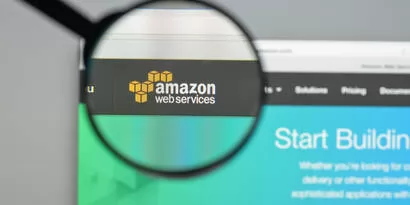
Application Modernization on AWS: Main Approaches & Techniques
Working with legacy applications can make you feel like you’re stuck in the past because, in a way (a very real way), you kind of are. In the spirit of embarking on a digital transformation journey, there’s no escaping the modernization of your applications as you work towards ensuring agility, responsiveness, and driving innovation forward.
According to a recent research, the global application modernization services market is projected to grow from USD 15.2 billion in 2022 to USD 32.8 billion by 2027. The modernization of legacy applications becomes imperative today to meet modern business demands. Modernizing applications helps ensure you’re working with an up-to-date-, supported, optimized, and secured application. It is also a proven practice that lets organizations benefit from a modern look-and-feel that is pretty powerful when talking about the user experience.
After the unprecedented events that took place in 2020, businesses across all industries were left scrambling trying to figure out the best way to cope with changing business and user needs. As the world became even more interconnected thanks to software applications, organizations were tasked with delivering solutions, support, and ongoing services at break-neck speed.
After all this, organizations are now focused on prioritizing their digital transformation and app modernization strategies, which is what we’re here to talk about in this blog post. We will highlight one of the biggest allies that app modernization has: Amazon Web Services (AWS). So, without further ado, let’s get this show on the road!
What is Application Modernization?
Let us paint you a picture: It’s 2023, and for some reason, you have a walkman to listen to music. Yes, it’s a little bulky but it gets the job done, right? Well, think again. The portfolio of music you have available is severely reduced because, well, artists don’t use cassettes anymore for their music. It’s all streaming platforms like Spotify and Apple Music. Even if you’re an old soul and only listen to the oldies but goodies, you’re still at risk of losing your music because cassettes have an end of life. It’s time for you to modernize your music-listening device to a more recent one.
Well, the same goes for application modernization. In short, it’s the migration of legacy systems or applications to the latest platform or release version available, typically in the cloud, to ensure business continuity.
There are key factors driving the growth and importance of legacy application modernization. Namely, cloud services, workload migration to cloud or Service Oriented Structures (SOA) at a large scale, digital transformation, getting rid of outdated systems, and the increasing demand for modern infrastructure.
So, what does a modernized application look like?
- It’s packaged in lightweight containers;
- It contains loosely coupled microservices;
- It uses APIs to communicate, collaborate, and interact;
- It has a clear separation between stateless and stateful services;
- The cloud infrastructure is self-service and elastic;
- lt’s isolated from the server and from OS dependencies;
- It’s managed through DevOps processes;
- It comes with automated capabilities.
Now that you know what application modernization is and what it looks like, let’s see one of the most effective resources to achieve it.
The Importance of AWS Cloud Solutions for Applications
Modern application development best practices
No matter the industry, everyone is interested in achieving higher agility in their business processes. Especially after Covid-19, businesses are looking to build resilience and respond to changes more quickly. And let’s not forget that you now need to create easy-to-scale applications much faster and with a global reach.
Cue AWS which helps accelerate digital transformation by moving applications and workloads to the cloud. In the spirit of increasing agility and creating higher-quality applications, AWS is the driving force behind several best practices for modern application development, which include:
- Automate the release pipeline to update applications and infrastructure swiftly.
- Use microservices.
- Experiment through ownership.
- Automate security
- Leverage serverless technologies to simplify infrastructure management.
- Use infrastructure as code to model and supply resources.
- Increase observability to improve application performance.
With AWS, businesses can retain, retire, relocate, re-host, repurchase, re-platform, and refactor their applications and workloads. Whether you’re looking to gain portability, modernization, or agility benefits, AWS is a one-stop-shop for this and more.
Build better IT systems faster
Nimble applications are quick to respond to modern business needs. From quick-paced mission-critical applications to swift responsiveness to new changes, modernizing your application sets you on the right track to ensure your system behaves the way you want it to, giving users a superior experience.
Speed is more important than ever, especially with the sharp increase in business demands that put a significant strain on business applications, which is why it’s critical to optimize your applications in every way possible.
AWS application modernization helps you build IT systems faster and with high quality. With AWS in mind, engineers have a high-functioning environment that quickly transforms ideas into full-fledged, high-quality systems. From starting the build, deploying, running tests, and more, AWS reduces delays while simultaneously improving quality.
Reduce total cost of application running and support
In cloud-native AWS, you can easily address the needs of growth requirements, accessibility, and reliability. To top it off, AWS is also one of the most cost-effective resources you can leverage.
Well-known for its “pay for what you use” models, AWS houses over 160 services that make your legacy application modernization a breeze. You pay for the individual services you actually need instead of having to purchase bundles of services that you may not use in their entirety. There are no long-term contracts involved so you can easily pay for what you consume without worrying about hidden costs, effectively reducing the total cost of your application running as well as its support.
Main Application Modernization Approaches
Lift and shift
Cloud migration strategies mean more than a move from the existing application to the cloud. To this day, there are still many organizations that’d like to approach application modernization by performing a clean-cut “lift and shift” to the cloud without considering the overall wellbeing of the application.
The no-frills explanation of lift and shift is moving an existing application, along with its data and infrastructure, to the cloud, in this case, AWS, with minimal changes.
Some portions of the application can benefit from being left intact until the modernization process is almost complete as they’ll be easier to move without disrupting stability and reliability. Of course, lift and shift is not as easy as many would like to think; its complexity stems from understanding the underlying technology as well as understanding how to operate in the cloud.
Refactoring
Far more advanced, refactoring requires a full-blown re-architecting and re-coding of an application’s code to improve it altogether so that it benefits from cloud functionality and the AWS framework itself. Typically, refactoring deals with modifying middleware and application elements to take advantage of cloud-exclusive capabilities like microservices or going serverless.
Replatforming
Known to many as a lift and reshape, replatforming moves the assets of your application to the cloud with small tweaks and optimizations to benefit from the newly acquired cloud capabilities. For example, you could rewrite your application so it uses AWS databases or add automated auto-scaling. With replatforming, your application takes advantage of cloud infrastructure capabilities minus the resource strain that’s involved in refactoring.
Main Application Modernization Techniques on AWS
EC2 Cloud Computing
Did you know you can use AWS to rent virtual computers so you run your applications smoothly and with no infrastructure to worry about? Thanks to Amazon Elastic Compute Cloud, or EC2 for short, you get world-class access to secure and scalable computing prowess in the cloud.
You can choose the perfect selection of storage, processor, networking, OS, and purchase model to accelerate your AWS application modernization efforts. It gives you full control over scaling and computing resources.
Containers
Most legacy applications today were built before cloud computing became a thing. Keeping legacy apps running is one of the top reasons IT costs increase year over year, often becoming bottlenecks that prevent you from being responsive, cost-effective, and quick.
Containers are key in AWS and are orchestrated with Amazon Elastic Container Service (Amazon ECS). They boost automation and enable scaling up or down as needed, which is a must to address modern user-driven demands. Containers are a great ally for engineers to package application code, configuration, and dependencies into a self-contained, single object that runs as a resource-isolated process. Known for being lightweight, containers help provide a consistent and portable environment so applications can run and scale easily, anywhere. Containers are mostly used to build and deploy microservices, in machine learning, to run batch jobs, to move existing applications to the cloud, and much more.
Microservices
Decades ago, monolithic architectures were all the rage. Nowadays, as demands and complexity continue to increase, monolithic architectures are incapable of scaling as needed. As an application’s code grows, so does the complexity to maintain it and update it, which can be a significant limitation to introduce new features, frameworks, and technologies.
With a microservices architecture, each application’s components run as their own service, with no dependencies to other services, and using APIs as an effective means of communication between each other. Think of microservices as self-sufficient functions that are only tasked with performing that function well with no disruption or complexity of having to handle several services at once.
A microservices architecture makes it significantly easy to scale and be updated quickly and independently of other services.
Case in Point: US Manufacturing Company Migrated from Monolith to AWS-Powered Microservices, Improving System's Scalability and Performance
Serverless
Servers are one of the biggest headaches when talking about applications. In stark contrast to traditional cloud-based or server-centric infrastructures, AWS offers developers the opportunity to go serverless with AWS Lambda - for superior scalability, flexibility, cost-effectiveness, and quick time to release.
Even at large scale, going serverless is easy to set up and you only pay for the time your serverless capabilities are being used. By removing server management and operational overhead out of the equation, engineers can forget about tasks like capacity provisioning and patching, iterating to release to the market more quickly, with high-availability, and focus on building your app instead of configuring it, all while being confident that your resource utilization is optimized to the fullest.
Orchestration and Choreography
We’ve been talking about scalability quite a bit, but how exactly does AWS achieve superior scalability within a microservices architecture? Orchestration and Choreography are interaction methods where a controller or orchestrator controls how services interact, configuring business logic and ensuring everything happens at the right time, and choreographing or establishing patterns of how services work with no supervision and instructions.
The perfect balance of these two allows for a distributed and fail-proof process flow that makes the perfect case of easy scalability, helping you meet the needs of your business.
Conclusion
It's now more important than ever to bring a robust application modernization roadmap into the conversation. Outdated, legacy apps simply don’t do the trick anymore or have severe shortcomings that could hinder the success of your solutions.
Svitla Systems, an AWS Select Consulting Partner, has expertly led and overseen the end-to-end workflow of numerous application modernization projects orchestrated with the help of AWS. Our expert engineers are highly skilled at modernizing legacy applications from A to Z, caring for what matters to you most and taking your unique business needs into account.
Contact our experts to see all the ways we can help you in your application modernization endeavors.
Let's discuss your project
We look forward to learning more and consulting you about your product idea or helping you find the right solution for an existing project.
Your message is received. Svitla's sales manager of your region will contact you to discuss how we could be helpful.





